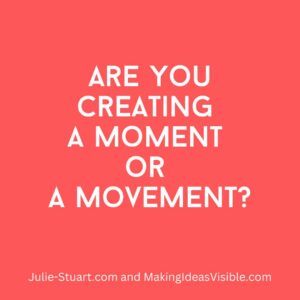Why in 2025 are we still doing conferences/meetings with the “sage on the stage” model–think keynote speakers and expert panels– which pushes content at attendees, and why are we not creating opportunities for people to engage and interact in ways that create lasting movements for the kind of change we want to see? Ask yourself if the purpose of your convening is to share content (sage on the stage) or is it to create an experience that is highly interactive, engaging and worthwhile in the moment, while also making an impact that lasts a lot longer than the duration of the conference.
Ever heard of the half-life of enthusiasm? It’s what happens to all that excitement generated during the conference that rapidly diminishes as soon as we pick up the work we left unattended to BE at the conference. Those intentions to have a follow up with the interesting people you met? They fade so fast once we’re busy back at our desk.
And here’s another challenge with the sage on the stage: people don’t have the attention span needed to consume six to eight hours of content in a day.
I remember more than ten years ago learning that scientists determined how long people could pay attention to a speaker before needing a break. It was 90 minutes. I’m sure that number is a lot less due to smartphones. Now it might be 15 to 20 minutes before people zone out. Maybe even 5.
How do conference organizers expect attendees to sit through a conference with six to eight hours of content fire-hosed at them, with only a lunch break, and expect them to absorb what’s being presented? And then come back for another day if the conference is 2 or 3 days-long.
So how do we change this?
Here’s what I would do.
Instead of loading up the conference with panel discussions and making people sit like couch potatoes through the content, let’s put some of it online ahead of time in the form of podcasts or video interviews. Create an engaging asynchronous Miro or Mural environment, encourage people to consume the content and interact with it, even reward them for their participation. Then they show up in person to your conference already immersed in the content and ready to engage.
Yes, I know there are folks who don’t do homework but there are ways to simplify and share the necessary bits. This content can also be consumed post-conference as an on-going library.
Then, make the conference as interactive and highly engaging as possible. Start the day with a World Cafe, a conversation process that seeds a couple of questions into the room that are aspirational and lets people imagine/dream of what can be different/better as they have conversations with each other at their table or small group. Five to eight people is ideal. After each question everyone forms a new group for the next question so automagically you’ve talked to a bunch of new people and your attendees understand that they are not going to be talked AT but instead will be active participants. Instant networking. The laptops and cellphones disappear. The energy level is raised. It’s inspiring. Liberating. Democratizing.
Now you have a convening where everyone gets to share their thoughts and everyone’s thoughts matter. Everyone is interesting at your conference not just your panel or keynote speakers. Now let your people get to work creating that different/better reality, together.
Throw some mindful physical movement moments in there to get people’s bodies in motion.
And if you’re still attached to the presenter/panel model then have a speaker or panel but make them interactive with polling or sticky notes, something that’s kinesthetic.
In the afternoon, switch to Open Space Technology. This process creates a marketplace of ideas where your participants offer topics they want to convene and contribute to. Attendees essentially design the conference content and engage in the meetings that most interest them by voting with their feet. These self-generated meetings are beehives of activity. Meeting notes are taken and shared after so you can see what other groups talked about. Actions are created. Steps to move the conversations forward start to happen. You can do several rounds of Open Space so people can work together, share ideas, build new networks, and move toward solutions.
Create an Idea Wall that attendees contribute to that harvests their best thinking on a topic(s) that you want to explore together. This is great for introverts who need time and space to reflect and process their thoughts.
What’s the big difference between these models? Active vs. passive. It’s up to you to decide what kind of experience you want to create for your attendees.
By giving people time and space to make real connections through unhurried conversations instead of overwhelming their brains with content, you’re letting them digest important information and explore their thoughts at a comfortable human pace.
And by getting them to engage together in Open Space, you’re modeling what a community of practice can look like. Very often the ideas and solutions that happen in a highly engaging conference/meeting become realities in the world. Isn’t this ultimately the outcome you want for your convening?

